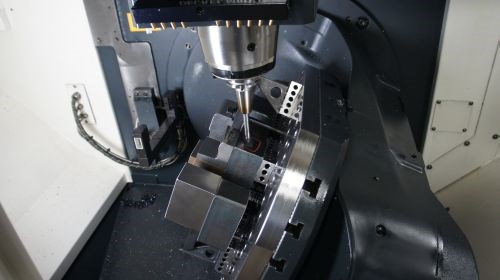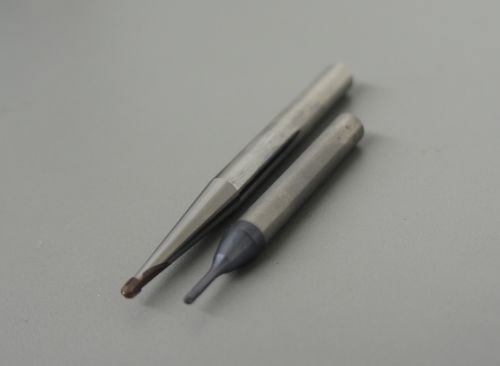Five-Axis Blends Require Minding Ballnose Tolerances
Proper symmetry, expressed via the end mill’s diameter and radius tolerance, is critical to ensure smooth surface finishes during five-axis contouring operations.

Die stamping components like this one are relatively rare at Legacy Precision Molds, which, true to its name, specializes mostly in plastic injection molds. However, 3+2 toolpaths like the one used for this part are quite common—more common, in fact, than full simultaneous contouring. Only when the shop made that leap (from 3+2 to full five) did it discover a need for new ballnose tooling.
At first, making the leap from 3+2 to full five-axis contouring didn’t look like a very promising development for Legacy Precision Molds (Grand Rapids, Michigan). Nine months after installing their first five-axis, a DMU 50 from DMG MORI, Tyler Vanree and the rest of the crew at this 14-employee shop were struggling to avoid blend lines on parts that would have posed no problems machining smooth on simpler equipment. As it turned out, however, the problem didn’t have anything to do with the shop’s newest machine, nor with its operators or programmers, VanRee says. Rather, the problem was with the cutting tools.
Not that there was anything wrong with those tools intrinsically. After all, ballnose cutters identical to those on the new five-axis machine had been employed on countless three-axis jobs over the years without issue. Yet, those designs simply wouldn’t stand up to the demands posed by five-axis machining, which requires a highly symmetrical ballnose profile to ensure smooth, line-free surfacing. These days, shop personnel insist that all tools employed for contouring have diameter and radius tolerances within ±0.0005 inch. At that level of precision, personnel can rest assured that machining will proceed exactly as planned even if different portions of the cutting edge engage the material at different points along the tool path.

Beyond tight tolerances, the shop appreciates the fact that Innova Tools VHM ballnose end mills are available with various neck lengths. This attribute saves time previously spent grinding shanks back, whether for rigidity, to ensure a tool fits in its heat-shrink holder, to better access features like vertical walls, or any of the above.
Of course, other shops with other priorities and specialties might specify different tolerance requirements for ballnose cutters. Whatever the level of precision, Vanree emphasizes the importance of considering both tolerance figures—that is, both radius tolerance and diameter tolerance—and checking the math. Although these dimensions are interlinked (that is, one figure depends largely on the other), cutting tool manufacturers often specify tighter tolerances for ballnose radii than for diameters.
“If you had a 0.25-inch-diameter cutter and swung a perfect radius from one side to the other, that radius would measure 0.125 inch—half the diameter,” Vanree explains. “If you shrink the diameter, the radius will shrink with it. That’s why having looser tolerance on the diameter than the radius can complicate things when you’re trying to program the toolpath. So, we try to find tools where diameter and radius tolerance figures match up as well as possible.”
Legacy Precision Molds has learned plenty more lessons since bringing in its first five-axis machining center. To learn more, keep an eye on this blog and for our February issue, which will include a feature article on the shop’s experience.
Related Content
Watchmaking: A Machinist’s View
Old-world craftsmanship combines with precision machining on a vertical machining center and Swiss-type lathe to produce some of the only U.S.-made mechanical wristwatch movements.
Read MoreThreading On A Lathe
The right choices in tooling and technique can optimize the thread turning process.
Read MoreWhen Organic Growth in Your Machine Shop Isn’t Enough
Princeton Tool wanted to expand its portfolio, increase its West Coast presence, and become a stronger overall supplier. To accomplish all three goals at once, acquiring another machine shop became its best option.
Read MoreVolumetric Accuracy Is Key to Machining James Webb Telescope
To meet the extreme tolerance of the telescope’s beryllium mirrors, the manufacturer had to rely on stable horizontal machining centers with a high degree of consistency volumetric accuracy.
Read MoreRead Next
3 Mistakes That Cause CNC Programs to Fail
Despite enhancements to manufacturing technology, there are still issues today that can cause programs to fail. These failures can cause lost time, scrapped parts, damaged machines and even injured operators.
Read MoreThe Cut Scene: The Finer Details of Large-Format Machining
Small details and features can have an outsized impact on large parts, such as Barbco’s collapsible utility drill head.
Read More







.jpg;maxWidth=300;quality=90)



.png;maxWidth=300;quality=90)
.png;maxWidth=300;quality=90)













